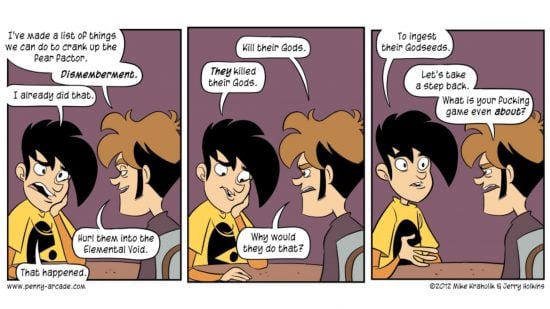When Wargamer interviewed Jerry Holkins, author and co-creator of long-running webcomic Penny Arcade, and the player behind half-elf Cleric Omin Drann in DnD actual-play series Acquisitions Incorporated, we took the opportunity to ask for his advice on how to be the best DnD DM we can.
In the first part of our interview, Holkins discussed how his upbringing during the satanic panic exposed him to oodles of undersung tabletop RPGs, and how that in turn affected his approach to playing and running DnD. But what is a game of DnD at Holkin’s table like, when he’s the Dungeon Master? Read on to find out…
How do you set the tone for a DnD campaign?
We might do what is now called a “session zero”, like an initial foray. But generally speaking it involves asking very personal questions of players – in secret! – before the game.
So the questions are:
- What’s your secret reason for joining the party?
- Who have you wronged?
- What would you kill to know?
If I have that information for a group of people then I start muder-walling these intimacies with each other.
It sounds like you’re setting up the pilot of a TV show.
Yeah, basically, I want to have the preconditions and the big questions set up with so much care that [the players] want to engage with it, and I can basically disappear.
So you’re absenting yourself from the game?
I feel like I have done my job when I can sit back and watch the players play. Like, not leave the table – I want to make sure that, especially when they’re finding out new things, the world has to be reactive.
We have a couple of Penny Arcade strips that don’t have any text. And as a writer, weirdly, I consider that the ultimate success – when no communication is required, it’s all there, and you can get from point to point, and there’s room for you to interpret. That’s more or less what I want to set up.
Where do monsters, plots, BBEGs come into it?
I want to set up and mash these interpersonal conflicts [with] conflicts with the world and wicked beasts, and clever antagonists that have all the reality and motivation of a player character. They are people for whom the player characters are their antagonists, their NPCs.
And once I have it set up to that level, they’ll just go. Then I can just come in and add texture. But once [the players] start engaging with each other, the sky is the limit.
Do the questions help players shape more effective characters?
Particularly if you have new players, people tend to arrive at tables with really epitomised versions of characters. Like versions of characters that are not really characters yet. They have their whole backstory, but it’s like there’s no real world around them. They just have their own personal sense of everything.
Such creatures, as soon as they hit the table and start interacting with other people, that’s when they really start to become real. And so that’s what I try to emphasise with the questions.
I want people to think about their characters as whole people and whole people are not epitomes. Whole people can be tricked into, or forced into, or in desperation, harm others, with the best of intentions. And that is where I like to come in.

It sounds like you see the role of the DM as being like Jigsaw from the Saw films?
[Laughing] Yeah, I mean, there’s something to like there because he’s not really present. He’s usually in an observational role. And it’s mostly about teaching these people hard lessons about themselves.
Thanks, Jerry!
We’ll have more from our interview soon, so make sure to check back. Check out our guide on how to be a DM for some more fundamental tips on the craft. And if you’ve always wanted to DM, but don’t think you’re good enough – just do it. As this article argues, it’s much easier, and even more rewarding, than you think.
Source: Wargamer




